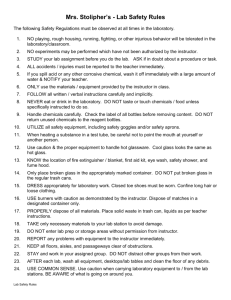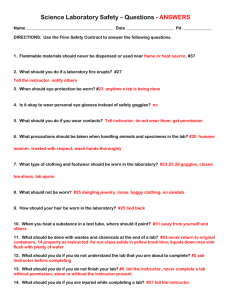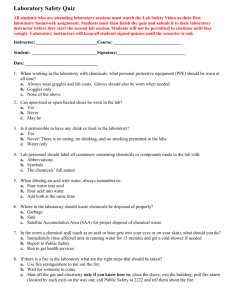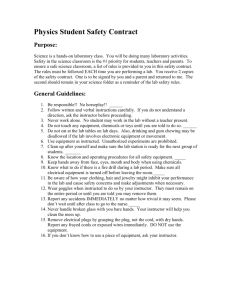on-campus manual for Lab 1
advertisement
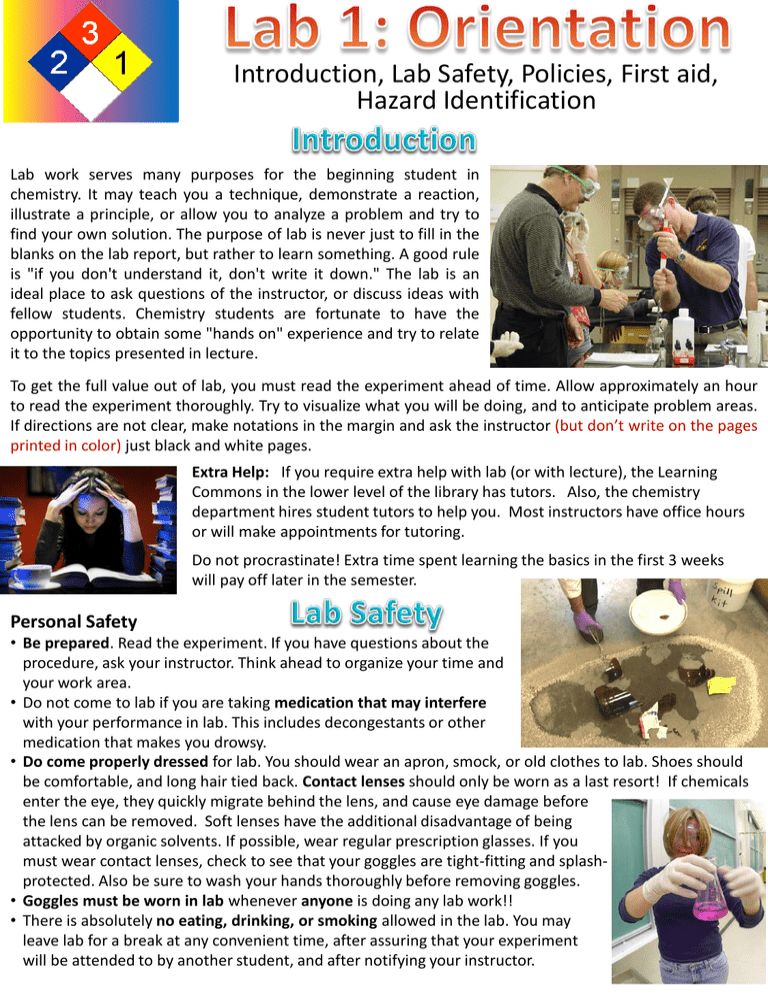
Introduction, Lab Safety, Policies, First aid, Hazard Identification Lab work serves many purposes for the beginning student in chemistry. It may teach you a technique, demonstrate a reaction, illustrate a principle, or allow you to analyze a problem and try to find your own solution. The purpose of lab is never just to fill in the blanks on the lab report, but rather to learn something. A good rule is "if you don't understand it, don't write it down." The lab is an ideal place to ask questions of the instructor, or discuss ideas with fellow students. Chemistry students are fortunate to have the opportunity to obtain some "hands on" experience and try to relate it to the topics presented in lecture. To get the full value out of lab, you must read the experiment ahead of time. Allow approximately an hour to read the experiment thoroughly. Try to visualize what you will be doing, and to anticipate problem areas. If directions are not clear, make notations in the margin and ask the instructor (but don’t write on the pages printed in color) just black and white pages. Extra Help: If you require extra help with lab (or with lecture), the Learning Commons in the lower level of the library has tutors. Also, the chemistry department hires student tutors to help you. Most instructors have office hours or will make appointments for tutoring. Do not procrastinate! Extra time spent learning the basics in the first 3 weeks will pay off later in the semester. Personal Safety • Be prepared. Read the experiment. If you have questions about the procedure, ask your instructor. Think ahead to organize your time and your work area. • Do not come to lab if you are taking medication that may interfere with your performance in lab. This includes decongestants or other medication that makes you drowsy. • Do come properly dressed for lab. You should wear an apron, smock, or old clothes to lab. Shoes should be comfortable, and long hair tied back. Contact lenses should only be worn as a last resort! If chemicals enter the eye, they quickly migrate behind the lens, and cause eye damage before the lens can be removed. Soft lenses have the additional disadvantage of being attacked by organic solvents. If possible, wear regular prescription glasses. If you must wear contact lenses, check to see that your goggles are tight-fitting and splashprotected. Also be sure to wash your hands thoroughly before removing goggles. • Goggles must be worn in lab whenever anyone is doing any lab work!! • There is absolutely no eating, drinking, or smoking allowed in the lab. You may leave lab for a break at any convenient time, after assuring that your experiment will be attended to by another student, and after notifying your instructor. Lab 1: Lab Safety Safety in Working with Chemicals • Read, understand, and follow directions. Perform only authorized experiments. If you wish to try your own idea, ask your instructor first. Fire • Read the label on all reagents carefully, and make sure it agrees with the chemical Hazard required in the experiment. Check the name and its concentration if listed. • MSDS: Learn about Material Safety Data Sheets (MSDS) and their value in Reactivity Health listing the dangers of various chemicals and how you may be exposed. (explosive) • NFPA: Learn about the ratings given by the National Fire Protection Association (NFPA), which are designed to be placed on diamond shaped Specific signs so that fire fighters would know what hazards were present when Hazard fighting a chemical fire. These signs are placed on transport vehicles, on buildings containing chemicals, and on containers of chemicals. Learn the color codes and number ratings for the types of hazards. See below Blue Red Yellow White Health: Fire Hazard: Reactivity Hazard: Specific Hazard: 4-Extremely poisonous 3-Poisonous 2-Moderately toxic 1-Slightly toxic 0-Non-toxic 4-Very Flammable 3-Readily Ignitable 2-Ignited with heat 1-Combustible 0-Will not burn 4-May easily Detonate (explode) 3-Shock & Heat may detonate 2-Violent chemical change 1-Unstable if heated 0-Stable OXY– Oxidizer (Concentrated source of oxygen or something that behaves like oxygen. Causes combustible material to easily catch fire.) ACID – Acid ALK – Alkali (corrosive to skin & reacts violently with acids) COR – Corrosive W – No water (H2O makes it worse) • Read safety precautions on the label and on the board. Assume all chemicals are poisonous; never taste them. Chemicals causing skin burns or giving off poisonous vapors will be carefully labeled for you. Use them with extra caution. Some chemicals are stored (and dispensed) under the exhaust hood to expel poisonous vapors. Do not remove these bottles from the hood. Reagent bottles • Keep all reagent bottles uncontaminated! Never take a reagent bottle to your desk. Bring a labeled container to the reagent shelf and take only as much of the reagent as you will need. Never insert a pipette, medicine dropper, or spatula into a reagent bottle. Recap the bottle. Your instructor will demonstrate how to pour liquids and solids out of reagent bottles easily and safely. If you do take too much, share with another student, or if that is not possible, ask the instructor for correct disposal methods. Also ask about correct spill cleanup procedure. Never put extra reagents back in the original containers! Other Safety Tips • Bunsen burners: Be sure there are no flammable liquids around before lighting a Bunsen burner. • Heating test tubes: Do not point mouth of the test tube towards yourself or your neighbor when heating liquid in a test tube. • Stir liquids with stirring rods, not metal spatulas. Many chemicals react with metal. • Glass: Be careful with glass! Don't use force on glass tubing or glass stirring rods. Also, hot glass, like hot beakers, takes a long time to cool, and looks just like cold glass (the same is true for metal). Dispose of broken glass in specific trash containers. • Electrical Safety: You drawer will contain a multi-meter capable of measuring low and high voltages. Check with instructor before using it to measure high voltages. • Ultraviolet & Laser Light Safety: Some labs use ultraviolet light sources and lasers. Wear eye protection when needed. Lab 1: Lab Safety: Emergency & First Aid Emergency and First Aid Procedures Notify your instructor or other chemistry department employee of any accident, no matter how large or small the problem appears to be. Serious or Life-Threatening Emergencies • Use stockroom phone. Dial Security at 57254 or Dial 9 then 911. Your location is : Phoenix College "C" Building N.W. Corner of 11th Ave. & Thomas Smaller Problems • Small Fires: Know the location and use of fire extinguishers. Read any instructions available for their use. Pull the pin before carrying the extinguisher. Squeeze the handle and direct the spray at the base of the flame. Smaller fires may be blown out, covered with a watch glass or wet paper towel, or doused with water or sand (or other inert powders). A person whose clothing is on fire can be wrapped in a fire blanket or held under the safety shower. They can also use the Stop, Drop and Roll method. • Chemicals in the Eye: Get to the eyewash FAST; don't wait to decide whether or not the chemical is harmful. Hold your face in the eyewash with both eyes open for at least 15 minutes. Have another student summon the instructor or stockroom personnel (note: this much exposure to cold water may result in temporarily-blurred vision but is necessary for complete chemical removal) • Chemicals on your skin: Wash them off with plenty of water. Let the water run for several minutes. If chemicals spill on your clothes or shoes, rinse them too. For large chemical spills use the safety shower. Note: It is good practice to wash your hands before leaving lab. Small amounts of chemicals can stain skin or cause irritation later. • Cuts: Do not attempt to remove glass from the cut. It may shatter into smaller pieces. If there is no glass in the cut, stop the blood flow by direct pressure on the wound. For small cuts, rinse with water. • Burns: Immerse the burn in cold water. Notify your instructor immediately. For first-degree burns (reddened skin) keep the burn in cold water until the pain is no longer noticed. Second or third degree burns require medical attention. General Comments • Report all injuries to the instructor as soon as possible. • Take the initiative to help students involved in accidents. People often panic and must be led to safety showers, eyewashes, etc. • Be sure that you have a signed emergency card on file with the stockroom. Lab 1: Stockroom Policies Stockroom Policies Lab Lockers and Equipment Check-in: You will be assigned a lab locker stocked with equipment you will need during the semester. Your locker will be your own, or you may need to share it with a lab partner from your class. Check the equipment against the inventory form at the end of this book and initial each item present and in good condition. List all missing items on a piece of paper, have your instructor initial the paper, and present it to the stockroom in exchange for the required equipment. YOU ARE NOW RESPONSIBLE FOR ALL EQUIPMENT IN YOUR LAB LOCKER and for remembering the combination to your lock. As part of the check-in procedure, read the attached safety rules and regulations. Fill out the emergency card. Learn the location and proper use of first aid equipment and fire extinguishers. Check-out: You must check out of your locker whether you complete the course, drop the course, or withdraw from school! Failure to check out of lab will result in an “F” for the course, a $10.00 fine, and a hold on future registration and transcript requests. Any additional charges for breakage, equipment cleanup, or missing equipment will be added to your bill. Normally, checkout should be completed with your regular lab class under the direction of your instructor. No drop slips will be signed unless you have checked out of lab. Fees: The following fees may be charged: • Replacement cost for broken glassware or equipment. • Replacement cost for missing glassware or equipment (for example, leaving these at home and not returning them). • 25 cents for looking up your locker combination. Note: You are required to obtain goggles and keep them in your lab locker. Special Equipment and Unknowns Equipment that is used only for one lab period is checked out through the stockroom window and brought back (properly washed) before the end of the lab period. Unknown solutions and solids are handled in the same way. Be sure to record your unknown number on your lab report and on the sheet in the stockroom window. Makeup Labs You are responsible for notifying your instructor before (or at worst immediately after) you miss a lab. Your instructor and stockroom personnel will determine if you can make up the lab. There will be no unscheduled or unsupervised lab work!
